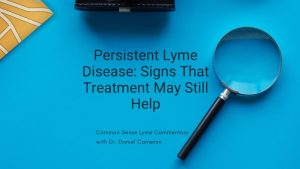Call for your appointment today 914-666-4665 | Mt. Kisco, New York

The authors looked at patients admitted to their infectious disease clinic in Australia between 2014 – 2020. “Patients were included if they had debilitating symptoms suggested by either themselves or the referring clinician as being attributed to ticks.”
They acknowledged that there are ill patients who have been seen at their infectious disease clinic who have been characterized as having “Australian Lyme” or Debilitating Symptom Complexes Attributed to Ticks.
The study included 29 patients with Debilitating Symptom Complexes Attributed to Ticks.
The authors were reluctant to diagnose their 29 referrals with Lyme disease if they did not meet the Royal College of Pathologists of Australasia [RCPA] diagnostic criteria for confirmed acute Lyme disease.
Four (16%) of the 29 referrals had at least 1 positive serological test collected > 30 days after symptom onset but did not meet the diagnostic criteria for acute infection.
Nineteen patients (66%) had positive serologies from non-NATA/RCPA-accredited institutions, such as IGeneX and Infectolabs.
The patients exhibited a range of symptoms. “Prior histories of anxiety (48%) and depression (41%) were common.” The most frequently reported symptoms included fatigue (83%), headache (72%) and arthralgia (69%).
The authors concluded their patients suffered from chronic fatigue syndrome, migraines, fibromyalgia and Medically Unexplained Illness (MUS).
“[MUS] is a new medically unexplained syndrome or an umbrella term for a range of disease or symptom processes,” wrote the authors.
Most of their patients reported successful treatment with antibiotics. “Of 25 cases with available data, 23 (92%) had previously been prescribed antimicrobials, with 53% reporting benefit from them.”
The most common antibiotics prescribed were doxycycline, azithromycin, penicillin, and roxithromycin.
Some patients were treated longer than 30 days. “The median number of antimicrobials prescribed was 2 (maximum 9), with a median duration of antimicrobial use of 3 months (maximum 24 months),” wrote the authors.
“One patient was trialled on nine separate antibiotics over a 12-month period,” they wrote. One had a PORT placed for intravenous antibiotics.
One of the patients was prescribed $1200 of atovaquone. The authors stated that atovaquone has been used for treatment for Pneumocystitis carinii pneumonia. But they failed to mention that atovaquone is also used for the treatment of the tick-borne infection Babesia microti.²
Ten (53%) of the treated patients benefited from treatment but their symptoms recurred. Two failed treatment. The actual failure rate could not be determined as the authors only had access to patients referred to their infectious disease unit.
The authors did not address the diagnostic challenges in their limitations section. There are no reliable tests for fibromyalgia, chronic fatigue, or MUS.
Authors Note: I would argue that the adage “If it looks like a duck, swims like a duck and quacks like a duck, then it probably is a duck,” is applicable as the authors dispute the term “Australian Lyme.”
Related Articles:
Yale doctor says children don’t have Lyme disease but medically unexplained symptoms
References:
- Schnall J, Oliver G, Braat S, Macdonell R, Gibney KB, Kanaan RA. Characterising DSCATT: A case series of Australian patients with debilitating symptom complexes attributed to ticks. Aust N Z J Psychiatry. Aug 2022;56(8):974-984. doi:10.1177/00048674211043788
- Krause PJ, Telford SR, 3rd, Spielman A, et al. Concurrent Lyme disease and babesiosis. Evidence for increased severity and duration of illness. JAMA. Jun 5 1996;275(21):1657-60.




hello. Why do I almost always have burns on my thighs and an inexplicable throbbing and pain in my lower back?.. I’m young, 24 years old and I’ve been treated for lyme for 5 months. My symptoms come and go in the same day..you say that they have a certain time when they do this..what should I do? it must mean this..It s hard..
I have had to individualize antibiotic treatment for some patients. I also refer them to other specialists to rule out other conditions.
as an antibiotic, I treat myself with tinidazole before the injection and then I inject moldamine and take azitrox once a week. I follow a gluten, lactose and sugar diet. In addition to this, I also take a homeopathic treatment with only natural medicines. I discovered Lyme after It’s been 2 years and I’ve been treating myself with what I mentioned above for 5 months. And I’m going to start some hiberbara and hyperthermia sessions. If the symptoms I have fluctuate several times a day, does it mean that the treatment is working? Before I started this treatment, the symptoms were permanent and did not fluctuate at all. Is it normal for some symptoms to improve faster and some more difficult? Please give me an answer! Thank you!
I take a different approach to antibiotics. For example, once a week Zithromax may not be therapeutic. I also look for co-infections to include Babesia. Lastly, I advise other specialists to rule out other causes.
I don’t have babesia, I did tests for all the infections. What dose of azitrox do you recommend me to take per week? And I have one more question. Why do I have these oscillations or frequency on the same day that appear and disappear?
Does the rest of the treatment I’m doing seem ok to you? With injectable moldamine plus azotrox pill and tinidazole pill? And I’m also taking homeopathic treatment
I am not familiar with your protocol.
I had not found the tests for Babesia as helpful as I would like. I have patient’s whose symptoms fluctuate but none have reporte oscillations.
In the Kathleen Folbigg case DNA evidence was used to clarify the situation.
However in Australia Lyme immunology tests are used. These tests are highly suspect.
havent the authors heard of DNA.??
Much of the arguments come from NSW which has a poor reputation
NATA should be questioned
DNA tests in the USA are also debated.